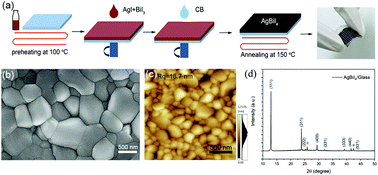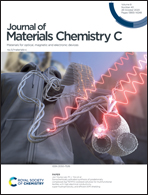High performance flexible memristors based on a lead free AgBiI4 perovskite with an ultralow operating voltage†
Abstract
Organic–inorganic halide perovskite materials exhibit excellent memristive properties, such as high ON/OFF ratio and low switching voltage. However, the toxicity of lead and poor stability strictly limit their further commercial applications. Herein, a high-quality nontoxic and stable AgBiI4 perovskite film is successfully synthesized via a low-temperature dynamic hot casting method, and resistive switching (RS) memory devices based on AgBiI4 are reported for the first time. The RS memory devices with the ITO substrate exhibit typical bipolar nonvolatile memory behaviors with an ultralow operating voltage (≈0.16 V), high ON/OFF ratio (≈104), reversible RS by pulse voltage operation (>700) and long data retention (>104 s), superior to those of most of the other perovskite-based memory devices. Furthermore, a high performance flexible nonvolatile resistive switching (RS) memory device based on a AgBiI4 perovskite with a PEN substrate is fabricated. The flexible device also displays good stability under repeated bending tests (>1000 cycles). By analyzing the current–voltage responses, and the transmission electron microscopy, energy dispersive spectroscopy and X-ray photoelectron spectroscopy results, we propose a mechanism involving conducting filaments formed by Ag cations to describe the RS behavior of the Ag/PMMA/AgBiI4/ITO device. Our work demonstrates that AgBiI4 is promising for nonvolatile memory devices and paves the way for realizing low-power consumption flexible nonvolatile memory devices.



 Please wait while we load your content...
Please wait while we load your content...